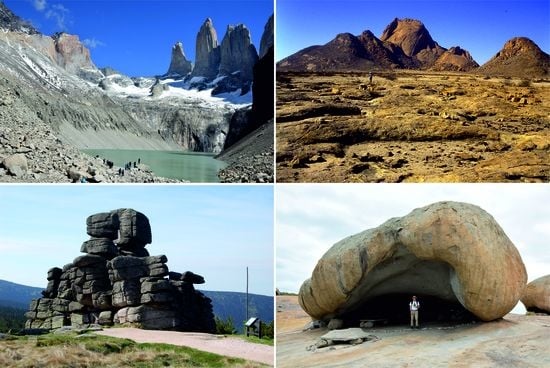Granite Landscapes, Geodiversity and Geoheritage—Global Context
Abstract
1. Introduction
2. Diversity of Granite Landscapes
2.1. Justification of Approach
2.2. Granite Relief Types and What They Tell
- Plains;
- Plains with residual hills;
- Multi-convex topography;
- Multi-concave topography;
- Plateaus;
- Dissected plateaus;
- Undulating hilly lands;
- Joint-valley topography;
- All-slopes relief;
- Stepped relief.
2.2.1. Plains
2.2.2. Plains with Residual Hills
2.2.3. Multi-Convex Topography
2.2.4. Multi-Concave Topography
2.2.5. Plateaus and Related Landscapes
2.2.6. Dissected Plateaus
2.2.7. Undulating Hilly Lands
2.2.8. Joint-Valley Topography
2.2.9. Stepped Relief
2.2.10. All-Slopes Relief
2.3. Characteristic Medium- and Small-Size Landforms
3. Granite Landforms and UNESCO World Heritage
3.1. Criteria
3.2. Current Representation
3.2.1. Granite Terrains Inscribed under Criterion (viii)
3.2.2. Granite Terrains Inscribed under Criterion (vii)
3.2.3. Granite Terrains Inscribed under Criteria (ix) and (x)
3.2.4. Granite Terrains within Cultural Properties
4. Granite Landforms and UNESCO Global Geoparks
5. Global Recognition—Challenges and Opportunities
6. Conclusions
Funding
Data Availability Statement
Acknowledgments
Conflicts of Interest
References
- Brocx, M.; Semeniuk, V. Geoheritage and geoconservation—History, definition, scope and scale. J. R. Soc. West. Aust. 2007, 90, 53–87. [Google Scholar]
- Gordon, J. Geoheritage, geotourism and the cultural landscape: Enhancing the visitor experience and promoting geoconservation. Geosciences 2018, 8, 136. [Google Scholar] [CrossRef]
- Gray, M. Geodiversity: Valuing and Conserving Abiotic Nature, 2nd ed.; Wiley Blackwell: Chichester, UK, 2013. [Google Scholar]
- Zwoliński, Z.; Najwer, A.; Giardino, M. Methods for assessing geodiversity. In Geoheritage, Assessment, Protection and Management; Reynard, E., Brilha, J., Eds.; Elsevier: Amsterdam, The Netherlands, 2018; pp. 27–52. [Google Scholar]
- Ollier, C.D. Problems of geotourism and geodiversity. Quaest. Geogr. 2012, 31, 57–61. [Google Scholar] [CrossRef]
- Prosser, C.D.; Díaz-Martínez, E.; Larwood, J.G. The Conservation of Geosites: Principles and Practice. In Geoheritage, Assessment, Protection and Management; Reynard, E., Brilha, J., Eds.; Elsevier: Amsterdam, The Netherlands, 2018; pp. 193–212. [Google Scholar]
- UNESCO Global Geoparks. Available online: www.unesco.org/new/en/natural-sciences/environment/earth-sciences/unesco-global-geoparks/fundamental-features (accessed on 31 December 2020).
- Reynard, E.; Fontana, G.; Kozlik, L.; Scapozza, C. A method for assessing scientific and additional values of geomorphosites. Geogr. Helv. 2007, 62, 148–158. [Google Scholar] [CrossRef]
- Reynard, E.; Perret, A.; Bussard, J.; Grangier, L.; Martin, S. Integrated approach for the inventory and management of geomorphological heritage at the regional scale. Geoheritage 2016, 8, 43–60. [Google Scholar] [CrossRef]
- Pereira, P.; Pereira, D.; Caetano Alves, M.I. Geomorphosite assessment in Montesinho Natural Park (Portugal). Geogr. Helv. 2007, 62, 159–168. [Google Scholar] [CrossRef]
- Vujičić, M.D.; Vasiljević, D.A.; Marković, S.B.; Hose, T.A.; Lukić, T.; Hadžić, O.; Janićević, S. Preliminary geosite assessment model (GAM) and its application on Fruška Gora mountain, potential geotourism destination of Serbia. Acta Geogr. Slov. 2011, 51, 361–377. [Google Scholar] [CrossRef]
- Kubaliková, L. Geomorphosite assessment for geotourism purposes. Czech J. Tour. 2013, 2, 80–104. [Google Scholar] [CrossRef]
- Różycka, M.; Migoń, P. Customer-oriented evaluation of geoheritage—On the example of volcanic geosites in the West Sudetes, SW Poland. Geoheritage 2018, 10, 23–37. [Google Scholar] [CrossRef]
- Brilha, J. Inventory and quantitative assessment of geosites and geodiversity sites: A review. Geoheritage 2016, 8, 119–134. [Google Scholar] [CrossRef]
- Migoń, P. Geoheritage and World Heritage. In Geoheritage. Assessment, Protection and Management; Reynard, E., Brilha, J., Eds.; Elsevier: Amsterdam, The Netherlands, 2018; pp. 237–249. [Google Scholar]
- Brilha, J. Geoheritage and Geoparks. In Geoheritage, Assessment, Protection and Management; Reynard, E., Brilha, J., Eds.; Elsevier: Amsterdam, The Netherlands, 2018; pp. 323–335. [Google Scholar]
- World Heritage Convention. Available online: https://whc.unesco.org/en/convention (accessed on 31 December 2020).
- Dingwall, P.; Weighell, T.; Badman, T. Geological World Heritage: A Global Framework; IUCN: Gland, Switzerland, 2005. [Google Scholar]
- Badman, T. World Heritage and geomorphology. In Geomorphological Landscapes of the World; Migoń, P., Ed.; Springer: Dordrecht, The Netherlands, 2010; pp. 357–368. [Google Scholar]
- McKeever, P.; Narbonne, G. Personal communication, 2020.
- Wood, C. World Heritage Volcanoes: Thematic Study; IUCN: Gland, Switzerland, 2009. [Google Scholar]
- Casadevall, T.; Tormey, D.; Roberts, J. World Heritage Volcanoes: Classification, Gap Analysis, and Recommendations for Future Listings; IUCN: Gland, Switzerland, 2019. [Google Scholar]
- Williams, P.W. World Heritage Caves and Karst. A Thematic Study; IUCN: Gland, Switzerland, 2008. [Google Scholar]
- Goudie, A.; Seely, M. World Heritage Desert Landscapes. Potential Priorities for the Recognition of Desert Landscapes and Geomorphological Sites on the World Heritage List; IUCN: Gland, Switzerland, 2011. [Google Scholar]
- Migoń, P. Granite Landscapes of the World; Oxford University Press: Oxford, UK, 2006. [Google Scholar]
- Operational Guidelines for the Implementation of the World Heritage Convention; UNESCO: Paris, France, 2019; Available online: Whc.unesco.org/en/guidelines (accessed on 31 December 2020).
- Wilhelmy, H. Klimamorphologie der Massengesteine; Westermann: Braunschweig, Germany, 1958. [Google Scholar]
- Thomas, M.F. Granite landforms: A review of some recurrent problems of interpretation. Inst. Br. Geogr. Spec. Publ. 1974, 7, 13–37. [Google Scholar]
- Godard, A. Pays et Paysages du Granite; Presses Universitaires de France: Paris, France, 1977. [Google Scholar]
- Twidale, C.R. Granite Landforms; Elsevier: Amsterdam, The Netherlands, 1982. [Google Scholar]
- Lidmar-Bergström, K. Relief and saprolites through time on the Baltic Shield. Geomorphology 1995, 12, 45–61. [Google Scholar] [CrossRef]
- Büdel, J. Die “Doppelten Einebnungsflächen” in den feuchten Tropen. Z. F. Geomorph. N. F. 1957, 1, 201–228. [Google Scholar]
- Thomas, M.F. The study of inselbergs. Z. F. Geomorph. N. F. Suppl. Bd. 1978, 31, 1–41. [Google Scholar]
- Twidale, C.R. Granite inselbergs: Domed, block-strewn and castellated. Geogr. J. 1981, 147, 54–71. [Google Scholar] [CrossRef]
- Ollier, C.D. Some features of granite weathering. Z. F. Geomorph. N. F. 1965, 9, 265–284. [Google Scholar]
- Thomas, M.F. Some aspects of the geomorphology of domes and tors in Nigeria. Z. F. Geomorph. N. F. 1965, 9, 63–81. [Google Scholar]
- King, L.C. The origin of bornhardts. Z. F. Geomorph. N. F. 1966, 10, 97–98. [Google Scholar]
- Twidale, C.R.; Bourne, J.A. Episodic exposure of inselbergs. Geol. Soc. Am. Bull. 1975, 86, 1473–1481. [Google Scholar] [CrossRef]
- Selby, M.J. Form and origin of some bornhardts of the Namib Desert. Z. F. Geomorph. N. F. 1982, 26, 1–15. [Google Scholar]
- Pye, K.; Goudie, A.S.; Thomas, D.S.G. A test of petrological control in the development of bornhardts and koppies on the Matopos Batholith, Zimbabwe. Earth Surf. Proc. Landf. 1984, 9, 455–467. [Google Scholar] [CrossRef]
- Pye, K.; Goudie, A.S.; Watson, A. Petrological influence on differential weathering and inselberg development in the Kora area of Central Kenya. Earth Surf. Proc. Landf. 1986, 11, 41–52. [Google Scholar] [CrossRef]
- Römer, W. The distribution of inselbergs and their relationship to geomorphological, structural and lithological controls in Southern Zimbabwe. Geomorphology 2005, 72, 156–176. [Google Scholar] [CrossRef]
- Matmon, A.; Mushkin, A.; Enzel, Y.; Grodek, T.; ASTER Team. Erosion of a granite inselberg, Gross Spitzkoppe, Namib Desert. Geomorphology 2013, 201, 52–59. [Google Scholar] [CrossRef]
- Migoń, P. Are any granite landscapes distinctive of the humid tropics? Reconsidering multiconvex topographies. Singap. J. Trop. Geogr. 2009, 30, 328–343. [Google Scholar] [CrossRef]
- Mäckel, R. Dambos and related landforms in Africa—an example for the ecological approach to tropical geomorphology. Z. F. Geomorph. N. F. Suppl. Bd. 1985, 52, 1–23. [Google Scholar]
- Thomas, M.F.; Thorp, M.B. Environmental change and episodic etchplanation in the humid tropics of Sierra Leone. In Environmental Change and Tropical Geomorphology; Douglas, I., Spencer, T., Eds.; Allen and Unwin: London, UK, 1985; pp. 239–267. [Google Scholar]
- Thomas, M.F. Models for landform development on passive margins. Some implications for relief development in glaciated areas. Geomorphology 1995, 12, 3–15. [Google Scholar] [CrossRef]
- Johansson, M.; Migoń, P.; Olvmo, M. Joint-controlled basin development in Bohus granite, SW Sweden. Geomorphology 2001, 40, 145–161. [Google Scholar] [CrossRef]
- Bremer, H. Intramontane Ebenen, Prozesse der Flächenbildung. Z. F. Geomorph. N. F. Suppl. Bd. 1975, 23, 26–48. [Google Scholar]
- Migoń, P.; Prokop, P. Landforms and landscape evolution in the Mylliem granite area, Meghalaya plateau, Northeast India. Singap. J. Trop. Geogr. 2013, 34, 206–228. [Google Scholar] [CrossRef]
- Linton, D.L. The problem of tors. Geogr. J. 1955, 121, 470–487. [Google Scholar] [CrossRef]
- Evans, D.J.A. Bodmin Moor. In Landscapes and Landforms of England and Wales; Goudie, A., Migoń, P., Eds.; Springer: Cham, Switzerland, 2020; pp. 257–268. [Google Scholar] [CrossRef]
- Gunnell, Y. Landscape evolution of Dartmoor, SW England: A review of evidence-based controversies and their wider implications for geoscience. Proc. Geol. Assoc. 2020, 131, 187–226. [Google Scholar] [CrossRef]
- Sugden, D.E. The selectivity of glacial erosion in the Cairngorm mountains. Inst. Brit. Geogr. Trans. 1968, 45, 79–92. [Google Scholar] [CrossRef]
- Hall, A.M.; Gillespie, M.R.; Thomas, C.W.; Ebert, K. Scottish landform examples: The Cairngorms—A pre-glacial upland granite landscape. Scot. Geogr. J. 2013, 129, 2–14. [Google Scholar] [CrossRef]
- Migoń, P.; Vieira, G.T. Granite geomorphology and its geological controls, Serra da Estrela, Portugal. Geomorphology 2014, 226, 1–14. [Google Scholar] [CrossRef]
- Votýpka, J. Tvary zvětrávání a odnosu žuly v severní částí Novobystřické vrchoviny. Sborník Ceskoslov. Společnosti Zeměpisné 1964, 69, 243–258. [Google Scholar]
- Migoń, P.; Różycka, M.; Michniewicz, A. Conservation and geotourism perspectives at granite geoheritage sites of Lower Austria. Geoheritage 2018, 10, 11–21. [Google Scholar] [CrossRef]
- Mezősi, G. Granite Weathering in the Velence Hills. In Landscapes and Landforms of Hungary; Lóczy, D., Ed.; Springer: Dordrecht, The Netherlands, 2015; pp. 89–95. [Google Scholar]
- Neto de Carvalho, C.; Rodrigues, J. Naturtejo UNESCO Global Geopark: The culture of landscape. In Landscapes and Landforms of Portugal; Vieira, G., Zêzere, J.L., Mora, C., Eds.; Springer: Cham, Switzerland, 2020; pp. 359–375. [Google Scholar]
- Mabbutt, J.A. A study of granite relief from South West Africa. Geol. Mag. 1952, 89, 87–96. [Google Scholar] [CrossRef]
- Bremer, H. Reliefformen and reliefbildende Prozesse in Sri Lanka. Reliefboden Paläoklima 1981, 1, 7–183. [Google Scholar]
- Wahrhaftig, C. Stepped topography of the southern Sierra Nevada, California. Geol. Soc. Am. Bull. 1965, 76, 1165–1190. [Google Scholar] [CrossRef]
- Migoń, P.; Kasprzak, M.; Woo, K.-S. Granite landform diversity and dynamics underpin geoheritage values of Seoraksan Mountains, Republic of Korea. Geoheritage 2019, 11, 751–764. [Google Scholar] [CrossRef]
- Hirata, Y.; Chigira, M. Landslides associated with spheroidally weathered mantle of granite porphyry induced by 2011. Typhoon Talas in the Kii Peninsula, Japan. Eng. Geol. 2019, 260, 105217. [Google Scholar] [CrossRef]
- Bozhkov, P. Quantitative analysis of a stone run in Vitosha Mountain. In Proceedings of the International Scientific Conference Geobalcanica 2020, Ohrid, North Macedonia, 12–13 May 2020; pp. 137–143. [Google Scholar]
- Michniewicz, A.; Jancewicz, K.; Migoń, P. Large-Scale Geomorphological Mapping of Tors—Proposal of a Key and Landform Interpretation. Geomorphology 2020, 357, 107106. [Google Scholar] [CrossRef]
- Michniewicz, A. Tors in Central European Mountain—Are they indicators of past environments? Bull. Geogr. Phys. Geogr. Ser. 2019, 16, 67–87. [Google Scholar] [CrossRef]
- André, M.F. The geomorphic impact of glaciers as indicated by tors in North Sweden (Aurivaara, 68° N). Geomorphology 2004, 57, 403–421. [Google Scholar] [CrossRef]
- Migoń, P.; Maia, R.P. Pai Mateus, Pedra da Boca and Quixadá—Three possible Key Geoheritage Areas in north-east Brazil. Geoheritage 2020, 12, 51. [Google Scholar] [CrossRef]
- Twidale, C.R.; Vidal Romaní, J.R. Landforms and Geology of Granite Terrains; Balkema: Leiden, The Netherlands, 2005. [Google Scholar]
- Vieira, G.; Nieuwendam, A. Glacial and periglacial landscapes of the Serra da Estrela. In Landscapes and Landforms of Portugal; Vieira, G., Zêzere, J.L., Mora, C., Eds.; Springer: Cham, Switzerland, 2020; pp. 185–198. [Google Scholar]
- Migoń, P. The significance of landforms—The contribution of geomorphology to the World Heritage Programme of UNESCO. Earth Surf. Proc. Landf. 2014, 39, 836–843. [Google Scholar] [CrossRef]
- Mitchell, N.; Leitão, L.; Migon, P.; Denyer, S. Study on the Application of Criterion (vii): Considering Superlative Natural Phenomena and Exceptional Natural Beauty within the World Heritage Convention; IUCN: Gland, Switzerland, 2013. [Google Scholar]
- Huber, N.K. The geologic story of Yosemite National Park. USA Geol. Surv. Bull. 1987, 1595, 1–64. [Google Scholar]
- Yosemite National Park. Available online: Whc.unesco.org/en/list/308 (accessed on 31 December 2020).
- El Pinacate and Gran Desierto de Altar Biosphere Reserve. Available online: Whc.unesco.org/en/list/1410 (accessed on 31 December 2020).
- Thomas, M.F. Sanqingshan: The incredible granite peaks of eastern China. In Geomorphological Landscapes of the World; Migoń, P., Ed.; Springer: Dordrecht, The Netherlands, 2010; pp. 283–291. [Google Scholar]
- Migoń, P.; Woo, K.-S.; Kasprzak, M. Landform recognition in granite mountains in East Asia (Huangshan and Sanqingshan, China and Seoraksan, Republic of Korea)—A contribution of geomorphology to the UNESCO World Heritage. Quaest. Geogr. 2018, 37, 103–114. [Google Scholar] [CrossRef]
- Cui, Z.; Chen, Y.; Yang, X. Granite landform characteristics, distribution and evolution pattern in Huangshan Mt. Chin. Sci. Bull. 2009, 54, 4487–4499. [Google Scholar] [CrossRef][Green Version]
- Vilímek, V.; Zvelebil, J.; Klimeš, J.; Patzelt, Z.; Astete, F.; Kachlík, V.; Hartvich, F. Geomorphological research of large-scale slope instability at Machu Picchu, Peru. Geomorphology 2007, 89, 241–257. [Google Scholar] [CrossRef]
- Cottam, M.A.; Hall, R.; Sperber, C.; Kohn, B.P.; Forster, M.A.; Batt, G.E. Neogene rock uplift and erosion in northern Borneo: Evidence from the Kinabalu granite, Mount Kinabalu. J. Geol. Soc. 2013, 170, 805–816. [Google Scholar] [CrossRef]
- Hall, R.; Cottam, M.; Suggate, S.; Tongkul, F.; Sperber, C.; Batt, G. The Geology of Mount Kinabalu; Sabah Parks Publication: Sabah, Malaysia, 2008. [Google Scholar]
- Hope, G.S. Glaciation of Malaysia and Indonesia, excluding New Guinea. In Quaternary Glaciations: Extent and Chronology: Part III: South America, Asia, Africa, Australia, Antarctica; Ehlers, J., Gibbard, P.L., Eds.; Elsevier: Amsterdam, The Netherlands, 2004; pp. 211–214. [Google Scholar]
- Central Suriname Nature Reserve. Available online: Whc.unesco.org/en/list/1017 (accessed on 31 December 2020).
- Manovo-Gounda St Floris National Park. Available online: Whc.unesco.org/en/list/475 (accessed on 31 December 2020).
- World Heritage List. Available online: Whc.unesco.org/en/list (accessed on 31 December 2020).
- Fernandes, N.; Tupinambá, M.; Mello, C.L.; de Peixoto, M.N.O. Rio de Janeiro: A metropolis between granite-gneiss massifs. In Geomorphological Landscapes of the World; Migoń, P., Ed.; Springer: Dordrecht, The Netherlands, 2010; pp. 89–100. [Google Scholar]
- Rio de Janeiro: Carioca Landscapes between the Mountain and the Sea. Available online: Whc.unesco.org/en/list/1100 (accessed on 31 December 2020).
- Katupotha, J.; Kodituwakku, K. Utility of inselbergs and boulders as rock-shelter monasteries: A geoarchaeological study of Sigiriya and its environs. J. Soc. Sci. Hum. 2015, 1, 354–360. [Google Scholar]
- Jayasingha, P. Geological background of some archaeological sites of Sri Lanka. In Sirinimal Lakdusinghe Felicitation Volume; Gunawardhana, P., Ed.; Neptune Publication: Battaramulla, Sri Lanka, 2010; pp. 303–313. [Google Scholar]
- Matobo Hills. Available online: Whc.unesco.org/en/list/306 (accessed on 31 December 2020).
- Broderick, T.; Hubbard, P. The Matobo Hills of Zimbabwe: A perfect blend of geology, scenery and human history. In Africa’s Top Geological Sites; Anhaeusser, C.R., Viljoen, M.J., Viljoen, R.P., Eds.; Struik Nature: Cape Town, South Africa, 2016. [Google Scholar]
- Cotterill, F.P.D.; Hartley, R.R. Physical features of the Matobo Hills. In The Natural History of the Matobo Hills; Cotterill, F.P.D., FitzPatrick, M.J., Duprée, J., Eds.; Matobo Conservation Society and Biodiversity Foundation for Africa: Bulawayo, Zimbabwe, 2018; pp. 18–34. [Google Scholar]
- Nowell, D.A.G. Mont-Saint-Michel, France: A world heritage site and cultural icon. Geol. Today 2004, 20, 30–33. [Google Scholar] [CrossRef]
- Ferrari, G.; Ciampalini, R.; Billi, P.; Migon, P. Geomorphology of the archaeological area of Aksum. In Landscapes and Landforms of Ethiopia; Billi, P., Ed.; Springer: Dordrecht, The Netherlands, 2015; pp. 147–161. [Google Scholar]
- Knight, J.; Harrison, S. Land’s End: Landscapes and mining at the tip of England. In Landscapes and Landforms of England and Wales; Goudie, A., Migoń, P., Eds.; Springer: Cham, Switzerland, 2020; pp. 269–280. [Google Scholar]
- Kullberg, M.C.; Kullberg, J.C. Landforms and geology of the Serra de Sintra and its surroundings. In Landscapes and Landforms of Portugal; Vieira, G., Zêzere, J.L., Mora, C., Eds.; Springer: Cham, Switzerland, 2020; pp. 251–264. [Google Scholar]
- Ruban, D. Representation of geologic time in the global geopark network: A web-page study. Tour. Manag. Persp. 2016, 20, 204–208. [Google Scholar] [CrossRef]
- List of UNESCO Global Geoparks (UGGp). Available online: http://www.unesco.org/new/en/natural-sciences/environment/earth-sciences/unesco-global-geoparks/list-of-unesco-global-geoparks (accessed on 31 December 2020).
- Sá, A.A.; Rocha, D. Arouca UNESCO Global Geopark: Geomorphological diversity fosters local development. In Landscapes and Landforms of Portugal; Vieira, G., Zêzere, J.L., Mora, C., Eds.; Springer: Cham, Switzerland, 2020; pp. 329–340. [Google Scholar]
- Vieira, G.; Castro, E.; Gomes, H.; Loureiro, F.; Fernandes, M.; Patrocínio, F.; Firmino, G.; Forte, J. The Estrela Geopark—From planation surfaces to glacial erosion. In Landscapes and Landforms of Portugal; Vieira, G., Zêzere, J.L., Mora, C., Eds.; Springer: Cham, Switzerland, 2020; pp. 341–357. [Google Scholar]
- Panizza, M. Geomorphosites: Concepts, methods and example of geomorphological survey. Chin. Sci. Bull. 2001, 46, 4–6. [Google Scholar] [CrossRef]
- Reynard, E. Geomorphosites: Definition and characteristics. In Geomorphosites; Reynard, E., Coratza, P., Regolini-Bissig, G., Eds.; Pfeil Verlag: München, Germany, 2009; pp. 9–20. [Google Scholar]
- Zouros, N. Geomorphosites within geoparks. In Geomorphosites; Reynard, E., Coratza, P., Regolini-Bissig, G., Eds.; Pfeil Verlag: München, Germany, 2009; pp. 105–118. [Google Scholar]
- Coratza, P.; Hobléa, F. The specificities of geomorphological heritage. In Geoheritage, Assessment, Protection and Management; Reynard, E., Brilha, J., Eds.; Elsevier: Amsterdam, The Netherlands, 2018; pp. 87–106. [Google Scholar]
- Jon, W.-S.; Ryang, D.-Z.; Ri, H.-Y. Natural heritage value of Mt. Kumgang and global comparative analysis. Geoheritage 2020, 12, 32. [Google Scholar] [CrossRef]
- Varajão, C.A.C.; de Alkmim, F.F. Pancas: The kingdom of bornhardts. In Landscapes and Landforms of Brazil; Vieira, B.C., Salgado, A.A.R., Santos, L.J.C., Eds.; Springer: Dordrecht, The Netherlands, 2015; pp. 381–388. [Google Scholar]
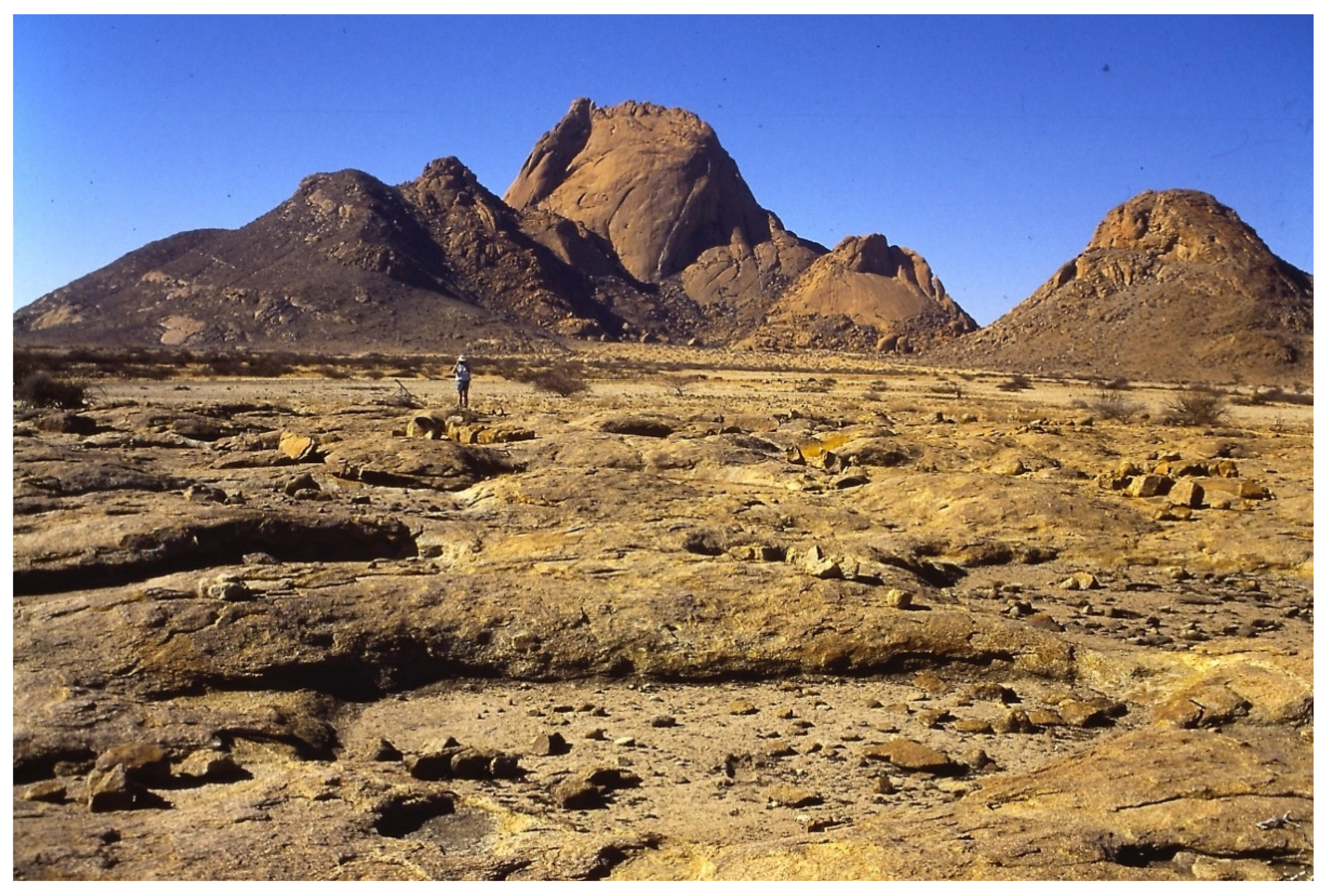
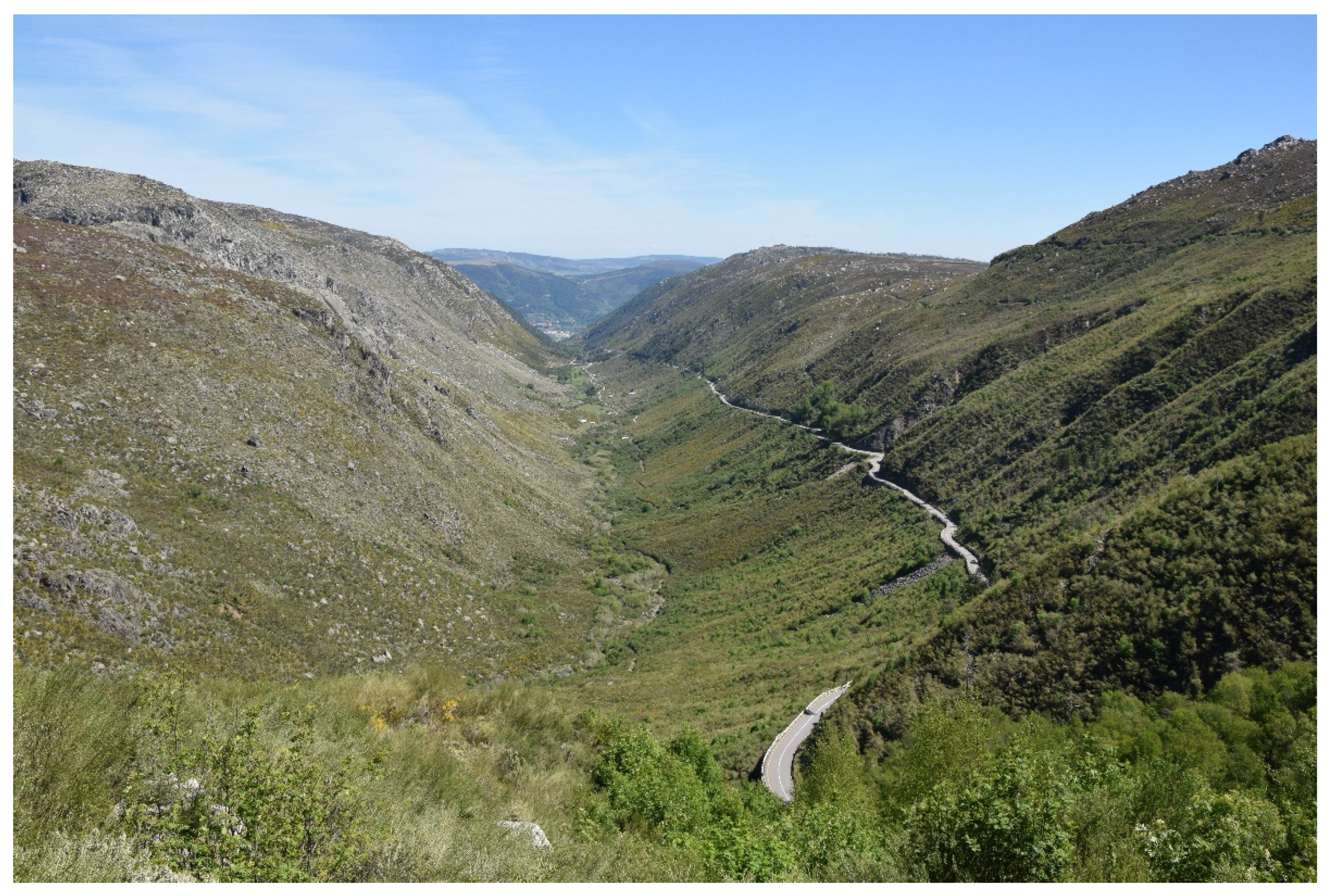
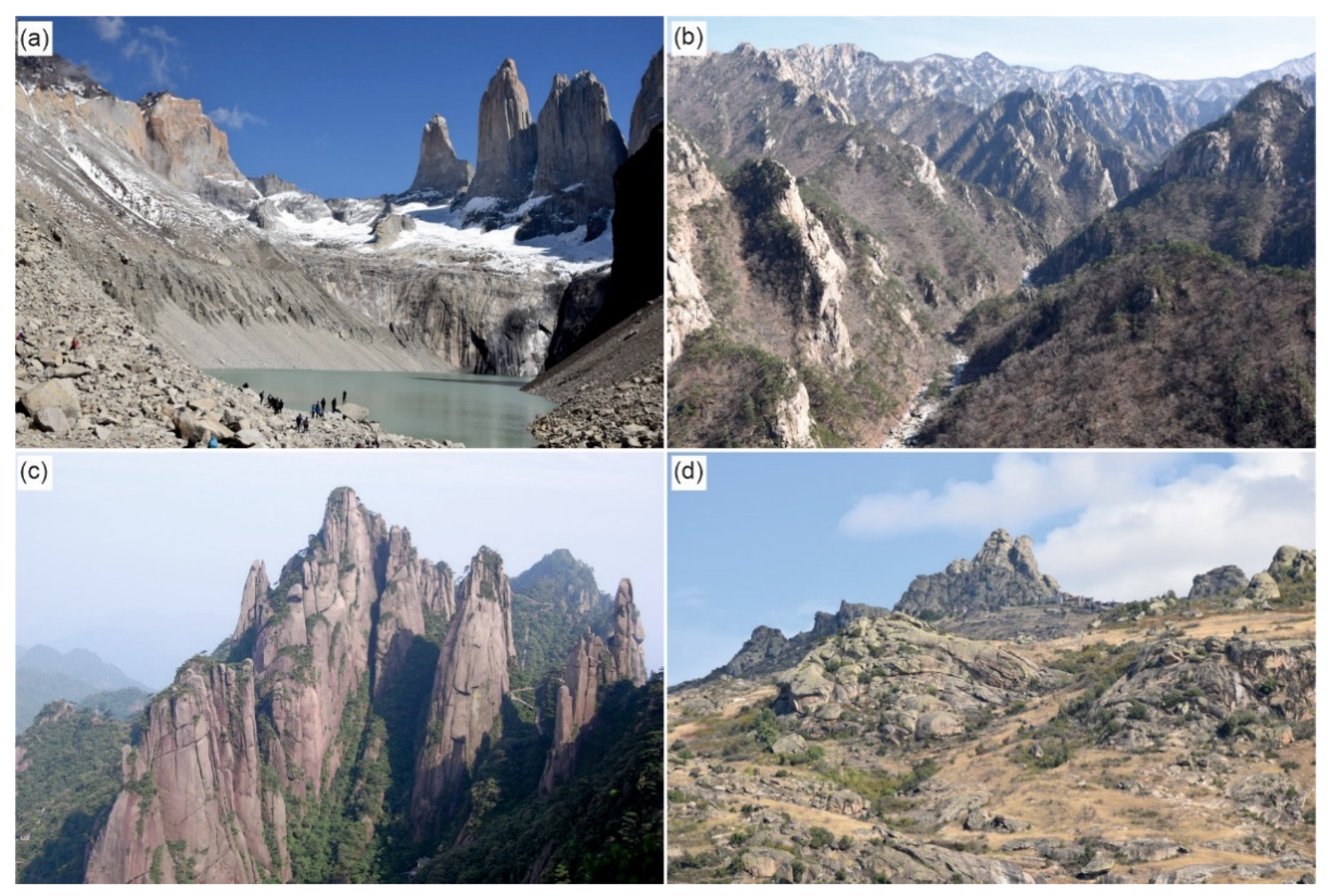
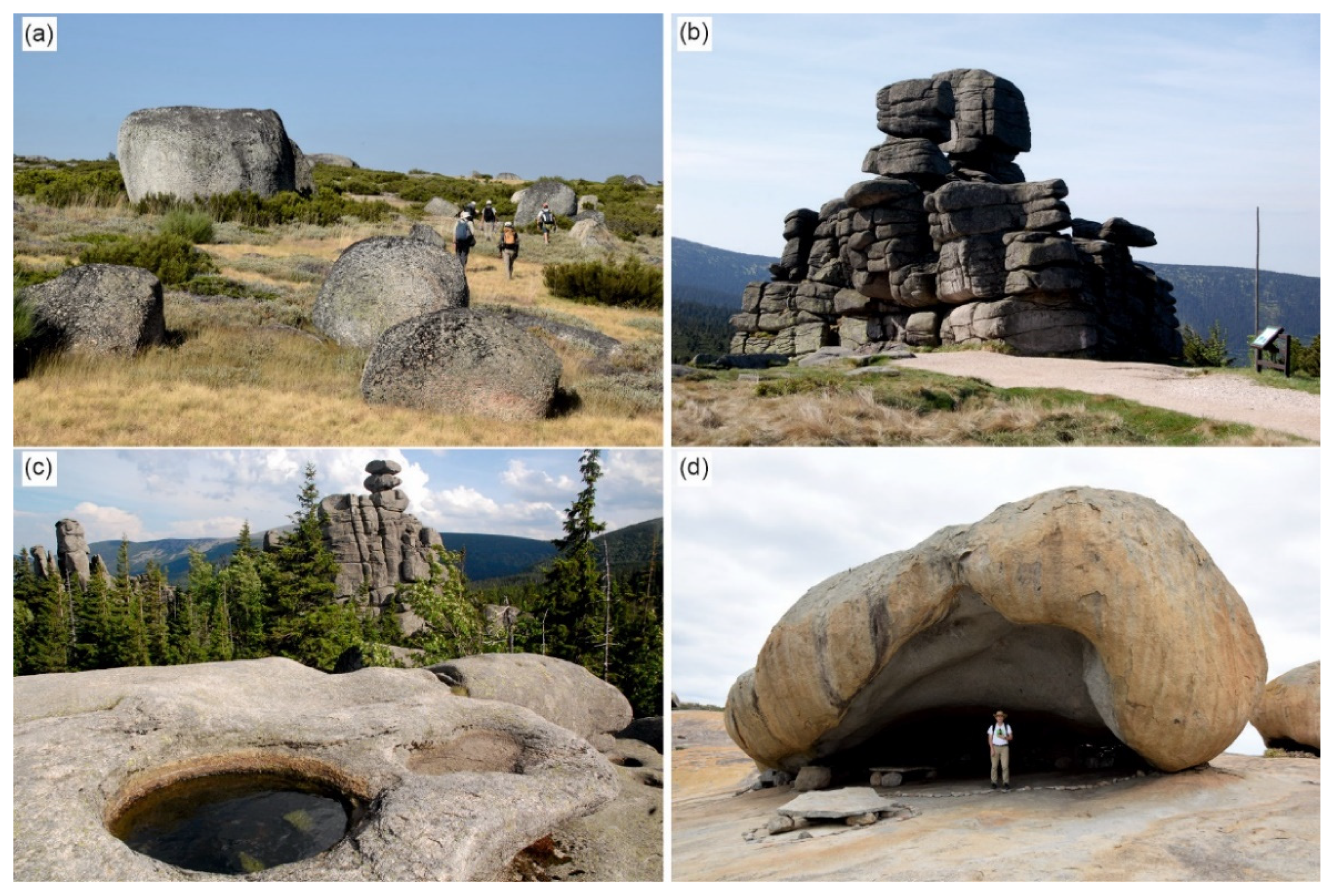
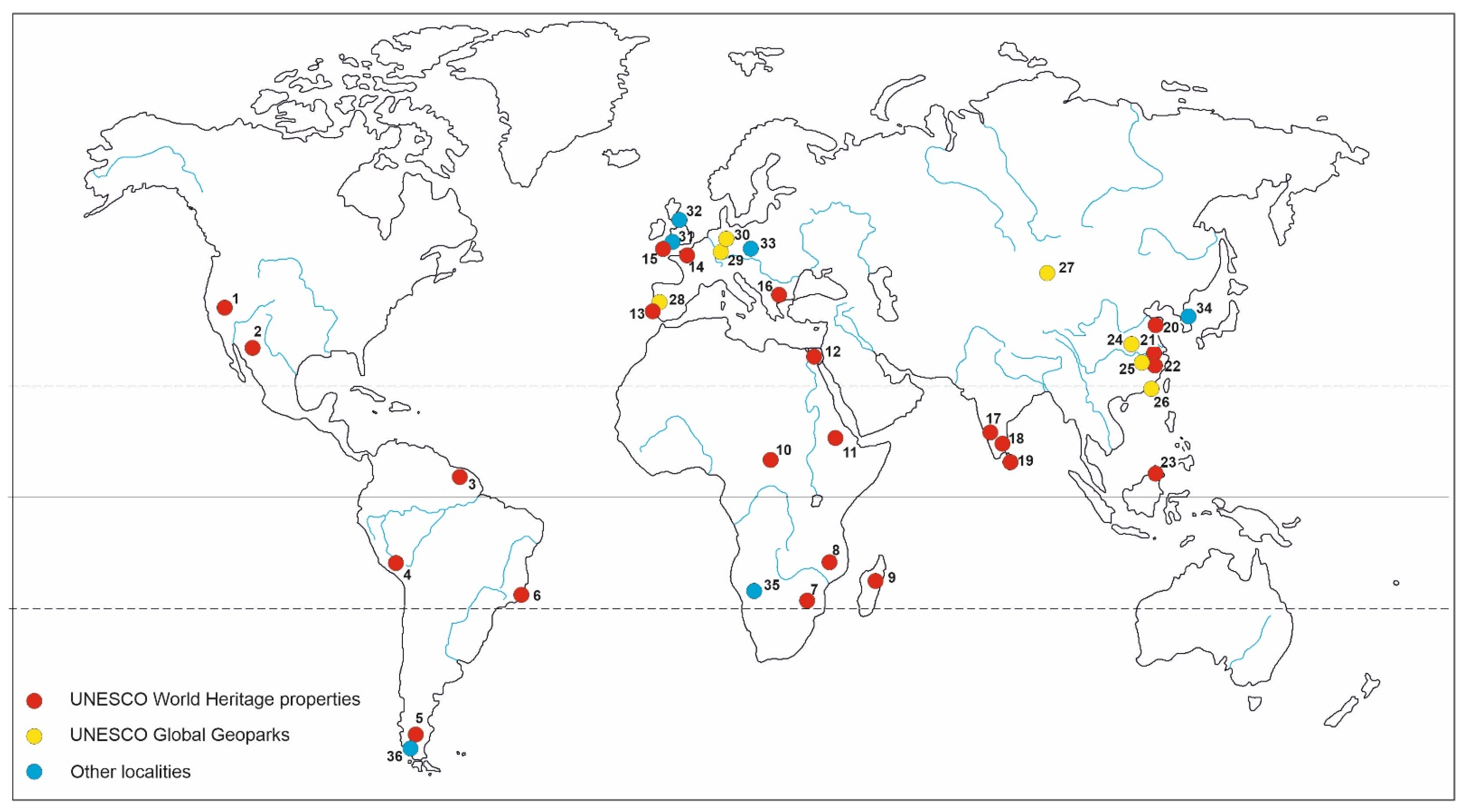
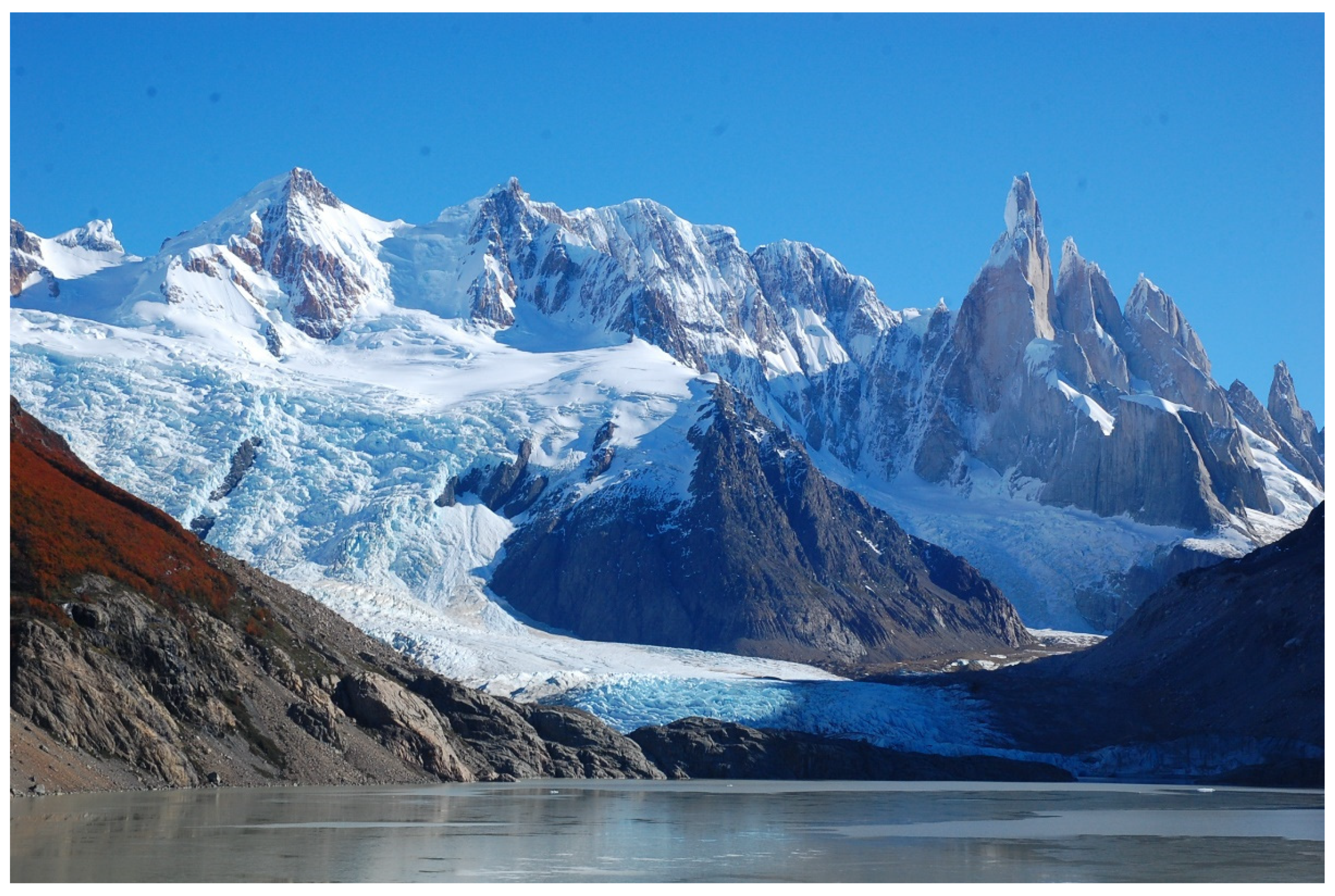
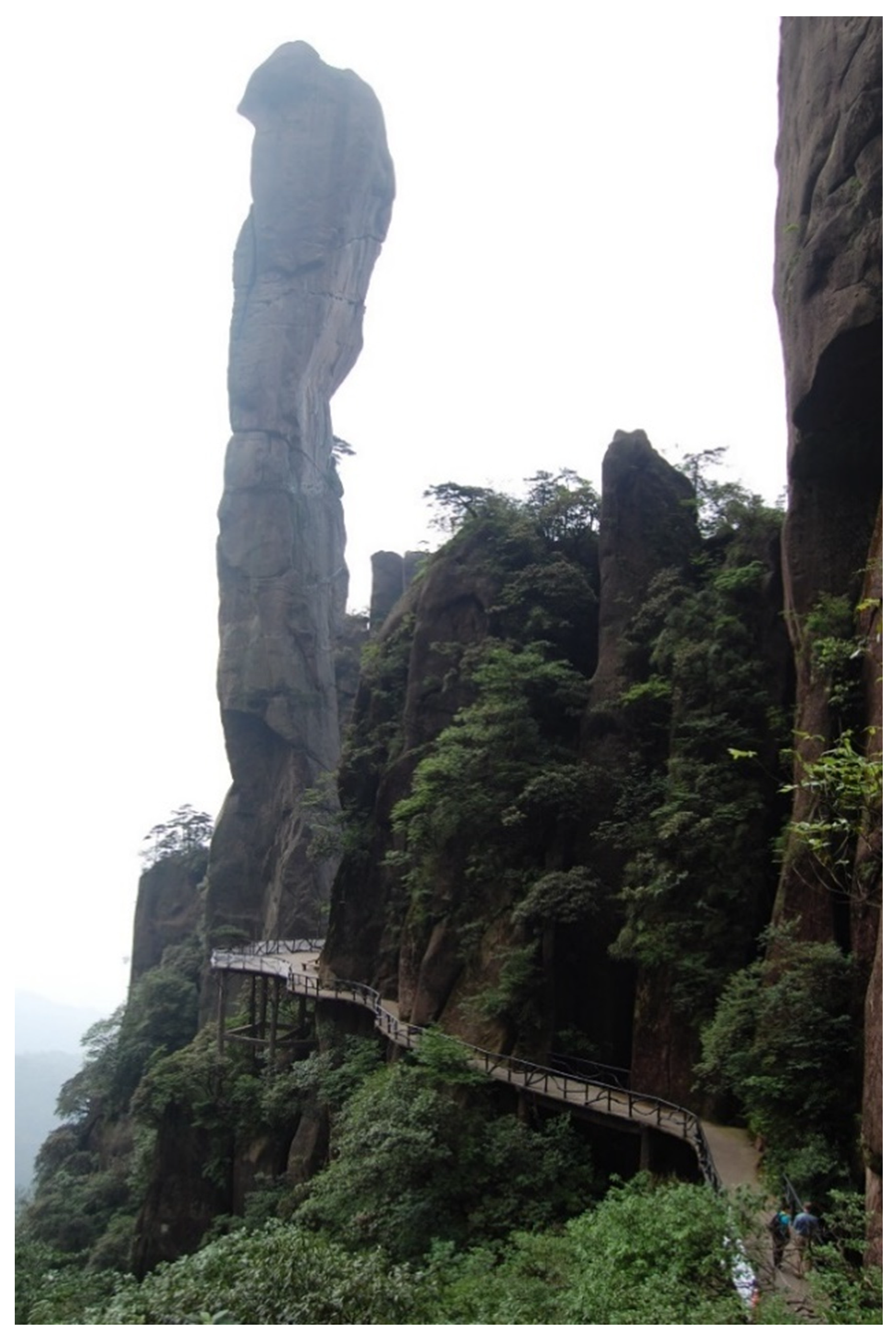
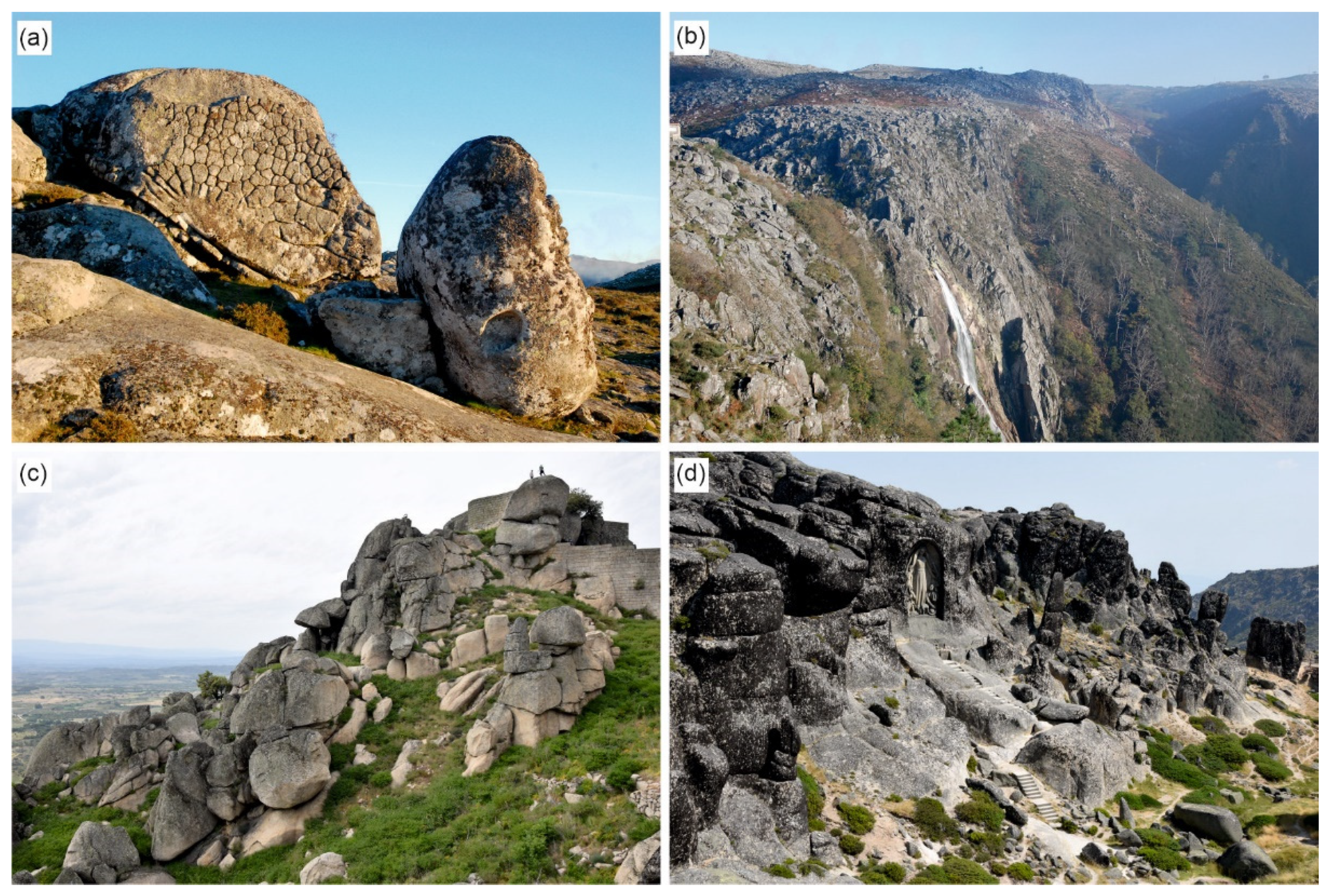
| World Heritage Property | Country | Year of Inscription | Criteria of Inscription | Type of Landscape | Specific Medium-Size and Minor Landforms of Interest | |||
|---|---|---|---|---|---|---|---|---|
| viii | vii | ix, x | i–vi | |||||
| Los Glaciares | Argentina | 1981 | x | x | All-slopes | Towers, pinnacles, cliffs | ||
| Pirin | Bulgaria | 1983 | x | x | x | All-slopes | Glacial cirques, arêtes | |
| El Pinacate and Gran Desierto | Mexico | 2013 | x | x | x | Plain with inselbergs | Conical hills, boulder mantles, pediments | |
| Yosemite | USA | 1984 | x | x | Dissected plateau | Domes and half-domes, glacial troughs, hanging valleys, waterfalls, talus deposits | ||
| Taishan | China | 1987 | x | x | All-slopes | Conical peaks, ridges, V-shaped valleys | ||
| Huangshan | China | 1990 | x | x | x | Dissected plateau All-slopes | Domes, hanging basins, waterfalls, joint-controlled ravines | |
| Sanqingshan | China | 2008 | x | All-slopes | Conical hills, pinnacles, joint-controlled ravines | |||
| Machu Picchu | Peru | 1983 | x | x | x | All-slopes | Domed and conical peaks, rock slopes | |
| Manovo-Gounda St Floris | Central African Republic | 1988 | x | Plain with inselbergs | Inselbergs | |||
| Mt Kinabalu | Malaysia | 2000 | x | All-slopes | Sheeting-related rock slabs, towers, glacial troughs, rockslide deposits | |||
| Central Suriname Nature Reserve | Suriname | 2000 | x | Plain with inselbergs | Domes | |||
| Rio de Janeiro | Brazil | 2012 | x | All-slopes | Domes | |||
| Saint Catherine Area | Egypt | 2002 | x | All-slopes | Conical peaks, joint-controlled ravines | |||
| Aksum | Ethiopia | 1980 | x | Plain with inselbergs | Tabular inselbergs, boulder fields, pediments | |||
| Mont Saint-Michel | France | 1979 | x | Inselberg | ||||
| Mahabalipuram | India | 1984 | x | Plain | Whalebacks, boulders | |||
| Hampi | India | 1986 | x | Multi-concave Undulating hilly land | Tors, boulders, minor topographic basins | |||
| Ambohimanga | Madagascar | 2001 | x | Inselberg | ||||
| Chongoni Rock-Art Area | Malawi | 2006 | x | Plain with inselbergs | Rock shelters | |||
| Sintra | Portugal | 1995 | x | Dissected plateau All-slopes | Tors, boulders | |||
| Sigiriya | Sri Lanka | 1982 | x | Plain with inselbergs | Inselberg, rock cliffs | |||
| Cornwall and West Devon Mining District | United Kingdom | 2005 | x | Plateau | Tors, boulder fields | |||
| Matobo Hills | Zimbabwe | 2003 | x | Multi-convex Joint-valley | Domes, tors, boulders, rock shelters | |||
| Continent | World Heritage | ||
|---|---|---|---|
| Criteria (vii, viii) 2 | Criteria (ix, x) | Cultural Properties (Criteria i–vi) | |
| North America | 2 | - | - |
| South America | 2 | 1 | 1 |
| Africa | - | 1 | 5 |
| Europe | 1 | - | 3 |
| Asia | 3 | 1 | 3 |
| Australia and Oceania | - | - | - |
| Total | 8 | 3 | 12 |
| World total | 252 3 | 869 | |
| Step | Activity |
|---|---|
| 1 | Identification of landscape type and selection of possibly comparative examples |
| 2 | Identification of possible sub-type (e.g., glacial or fluvial dissection for all-slopes topography; uplift or differential erosion for plateau origin) |
| 3 | Inventory of medium-size and minor landforms |
| 4 | Recognition of major stages in geological evolution: (a) age of granite intrusion (b) age of unroofing and timescale of landscape evolution (c) age of most recent uplift (if applicable) (d) impact of Quaternary environmental change |
Publisher’s Note: MDPI stays neutral with regard to jurisdictional claims in published maps and institutional affiliations. |
© 2021 by the author. Licensee MDPI, Basel, Switzerland. This article is an open access article distributed under the terms and conditions of the Creative Commons Attribution (CC BY) license (http://creativecommons.org/licenses/by/4.0/).
Share and Cite
Migoń, P. Granite Landscapes, Geodiversity and Geoheritage—Global Context. Heritage 2021, 4, 198-219. https://doi.org/10.3390/heritage4010012
Migoń P. Granite Landscapes, Geodiversity and Geoheritage—Global Context. Heritage. 2021; 4(1):198-219. https://doi.org/10.3390/heritage4010012
Chicago/Turabian StyleMigoń, Piotr. 2021. "Granite Landscapes, Geodiversity and Geoheritage—Global Context" Heritage 4, no. 1: 198-219. https://doi.org/10.3390/heritage4010012
APA StyleMigoń, P. (2021). Granite Landscapes, Geodiversity and Geoheritage—Global Context. Heritage, 4(1), 198-219. https://doi.org/10.3390/heritage4010012




